Are you thinking about planting a white-blooming vine in your garden, but you’re not sure where to begin? Many vines have eye-catching white flowers, and many may climb quickly with little care.
To help you select the ideal white flowering vine for your garden, we’ve looked at some of the best choices in this article!
1. White Mandevilla Vine
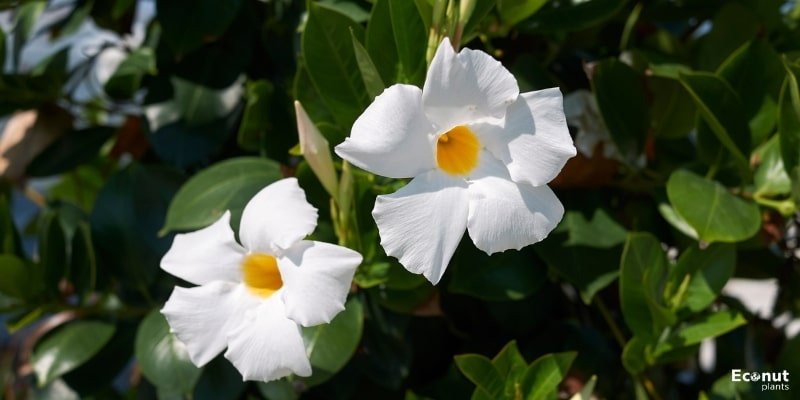
Scientific Name: Mandevilla boliviensis
Plant Type: Perennial
Sun Exposure: Full sun
Plant Size: 6-10 feet
Mandevilla vines may add colour to both your indoor and outdoor spaces. Wherever you plant it, this white-flowering mandevilla lends an air of sophistication!
Have you discovered a vine in bloom that you adore? Really, I hope so. Beautiful climbing plants can make for some truly stunning additions to a landscape. It’s amazing what a difference one or two plants can make. Go ahead and spruce up your house now! Cheers to your planting!
2. Snail Vine
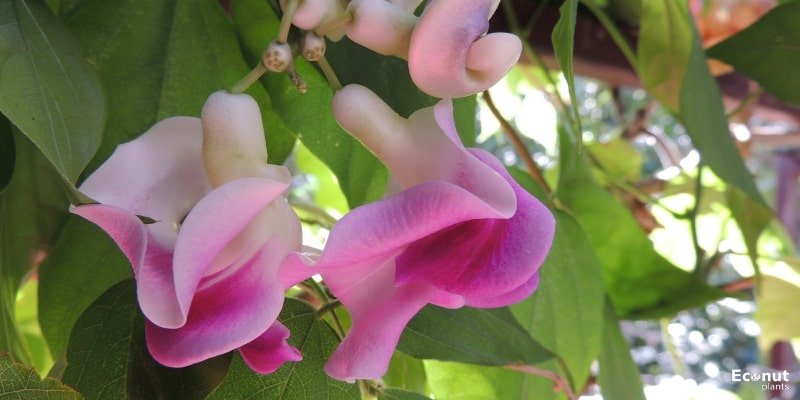
Scientific Name: Cochliasanthus caracalla
Plant Type: Perennial
Sun Exposure: Full Sun
Plant Size: 15-20 feet
Perennial flowering vines that thrive in areas free of frost are called snail vines. Its little blossoms are believed to resemble a snail’s coiled shell. These vines can reach a maximum length of 15 to 20 feet. To keep the vines vigorous and healthy, do some mild pruning on a regular basis to remove any dead or scraggly areas.
3. White Supreme Sweet Pea
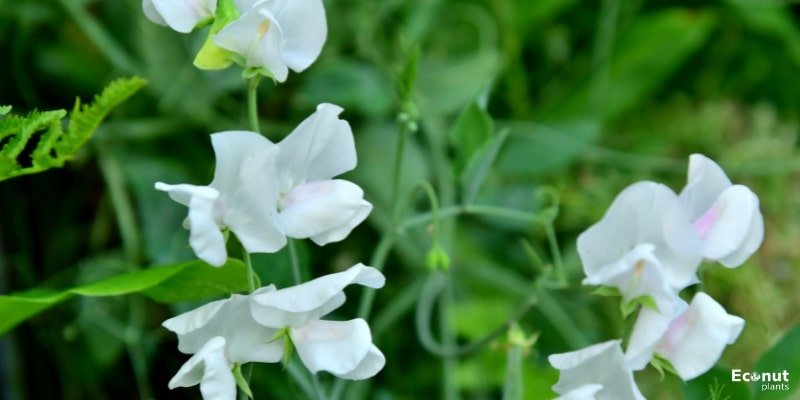
Scientific Name: Lathyrus odoratus ‘White Supreme’
Plant Type: Perennial
Sun Exposure: Full Sun
Plant Size: 6 to 8 feet
White Supreme is a graceful, fragrant flowering vine that has white blossoms. This plant can be grown in a garden, on a porch, or in a pot.
4. White Bougainvillea Vine
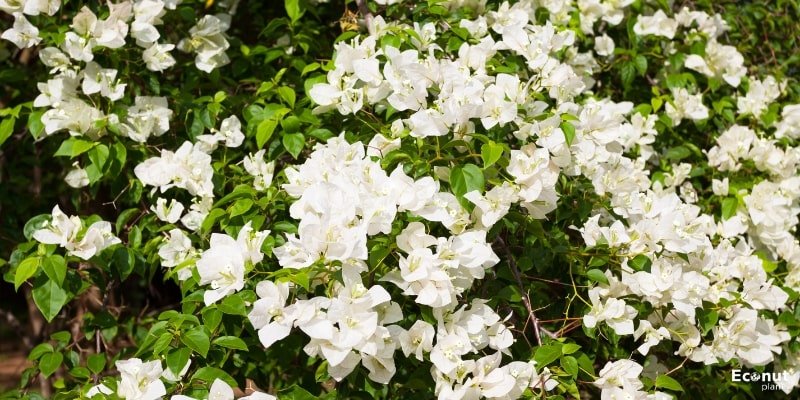
Scientific Name: Bougainvillea
Plant Type: Perennial
Sun Exposure: Full Sun
Plant Size: 15-40 feet
A beautiful tropical vining plant, bougainvillea has a woody stem and a summertime display of vivid flowers. It comes in a variety of hues. The tiny tubular blossoms on this climbing vine are grouped in clusters of three. Bracts of pink, red, orange, yellow, or white surround the flowers.
USDA zones 9 and 10 are ideal for the evergreen climbing vine known as bougainvillea. On spreading stems that can reach heights and widths of up to 40 feet, the tightly packed foliage is borne.
Bougainvillea is planted as an annual in cooler areas. Its leafy stems that cascade down look great in hanging baskets, and it contains flowers that might be white, pink, purple, red, or orange.
5. White Madagascar Jasmine
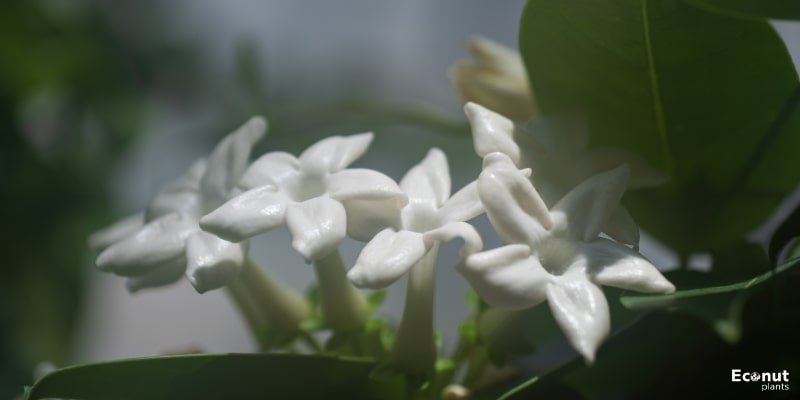
Scientific Name: Stephanotis floribunda
Plant Type: Perennial
Sun Exposure: Full Sun
Plant Size: 20 feet
The ideal growing conditions for Madagascar jasmine are partial to full light in USDA zones 10 and 11. Its clusters of tiny white blooms, which draw Eastern tiger swallowtail butterflies, are set against a backdrop of dark green leaves. Blooms may begin in the spring and last until the arrival of cold weather.
Known by another name, wedding wreath, this vine is popular for cutting flowers. It grows easily inside and can grow up to 20 feet in length outdoors. To reduce density, it prefers well-drained soil that is high in sand and peat.
6. Dewberry
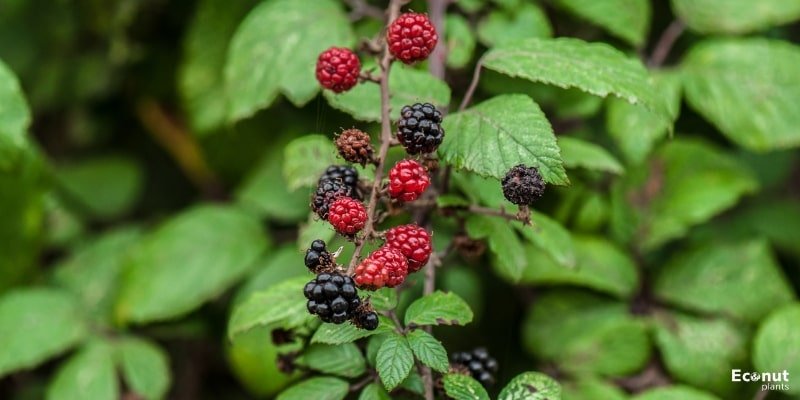
Scientific Name: Rubus Fruticosus
Plant Type: Perennial
Sun Exposure: Full Sun
Plant Size: 3-5 feet
Dewberry is a versatile and fragrant fruit that resembles a raspberry but has a slightly different flavor profile. They are often found in the wild, but they can also be cultivated.
Dewberries belong to the same family as blackberries and raspberries and are often mistaken for them due to their similar appearance. However, dewberries tend to be slightly larger and have a distinctively sweet and tangy taste.
In terms of culinary use, dewberries can be enjoyed fresh, used in jams, jellies, pies, and desserts, or incorporated into savoury dishes. They are also rich in vitamins and antioxidants, making them a nutritious addition to your diet. Dewberry picking is a popular activity in areas where they grow abundantly, providing a fun outdoor
7. Bleeding Heart Vine
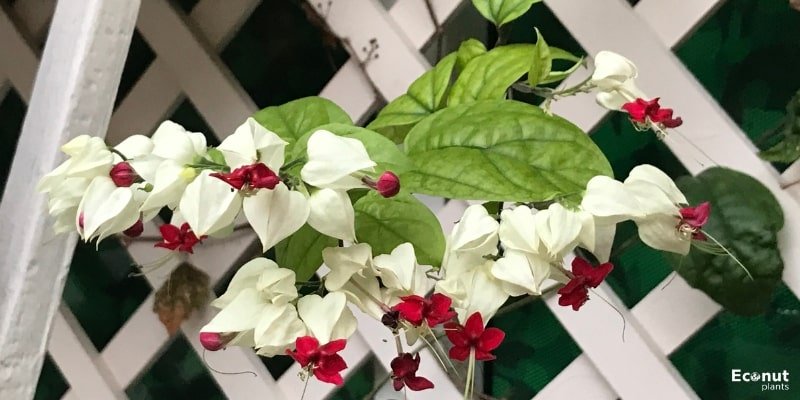
Scientific Name: Clerodendrum thomsoniae
Plant Type: Perennial
Sun Exposure: Partial Shade to Partial Sun
Plant Size: 15 feet
The bleeding heart plant bears clusters of white flowers with red accents in the springtime, along with delicate heart-shaped leaves.
The bleeding heart plant, which is frequently found in woodlands, thrives best in damp, shaded areas. The plant can be multiplied by division or seed.
If consumed in excessive numbers, bleeding heart plant leaves are toxic, and the sap can irritate skin. The plant is occasionally used as a natural treatment for sleeplessness and anxiety.
8. Moonflower
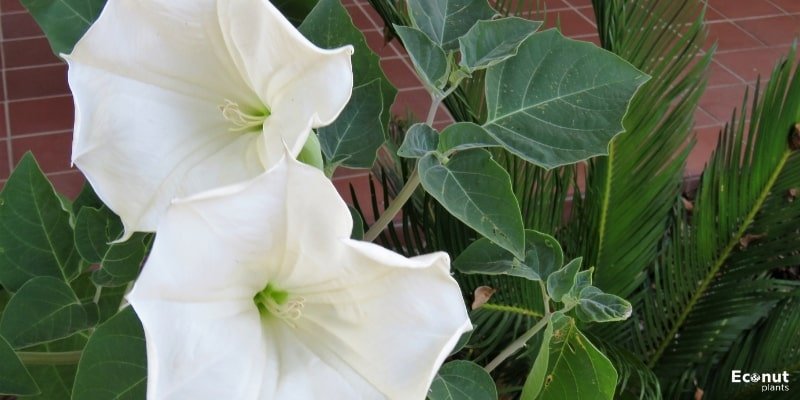
Scientific Name: Ipomoea alba
Plant Type: Perennial
Sun Exposure: Partial shade to full sun
Plant Size: 10–15 Feet
Heirloom favourites: moonflowers bloom in the dark and have 6-inch-wide blossoms! Additionally, they smell strongly, and pollinators love them! In cool areas, they are annual; in milder regions, they are perennial. They require full sunlight.
9. False Hydrangea Vine
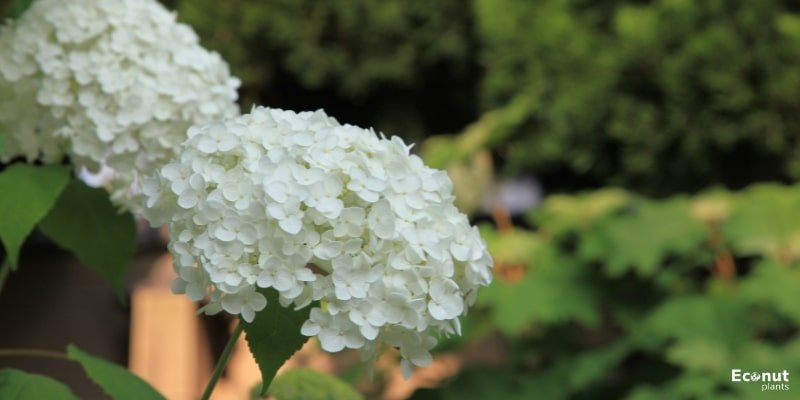
Scientific Name: Schizophragma hydrangeoides
Plant Type: Perennial
Sun Exposure: Partial sun to full shade
Plant Size: 60–80 Feet
This hydrangea-like plant bears flowers later in the season, although they resemble those of climbing hydrangea. In hues of creamy white or white, delicate flower panicles with a flat top and a diameter of 8 to 10 inches bloom in the middle of summer.
The peeling bark and reddish-brown stems provide winter attractiveness, while the deciduous foliage turns yellow in the fall. Grow this woody perennial vine that tolerates shade in a woody environment, training it up on a mature tree or other structure that can support its weight.
10. Climbing Hydrangea
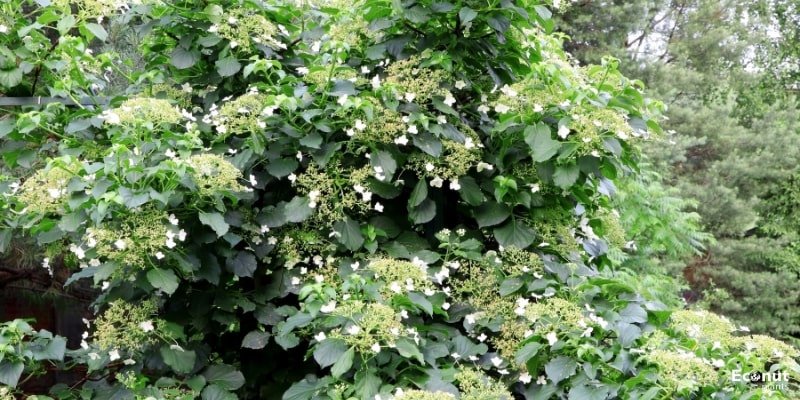
Scientific Name: Hydrangea anomala ssp. petiolaris
Plant Type: Perennial
Sun Exposure: Partial shade to full shade
Plant Size: 60–80 Feet
If a climbing hydrangea has a wall, fence, or big tree for its aerial rootlets to cling to, it can reach heights of 60 to 80 feet. In contrast to other plants with aerial roots, climbing hydrangea develops at a pace that makes control relatively easy.
This is a shade-loving plant that can only withstand full light if the soil is kept extremely wet. The dried flower heads and peeling bark offer the plant significant winter interest. The flowers are similar to those of shrub hydrangeas.
11. Sweet Autumn Clematis

Scientific Name: Clematis terniflora
Plant Type: Perennial vine
Sun Exposure: Full, partial
Plant Size: 15-30 feet
This is a pretty vine with fragrant, sweet-smelling blossoms. In late summer and early fall, the white blossoms of the Sweet Autumn Clematis draw hummingbirds and butterflies.
12. Honeysuckle Vine

Scientific Name: Lonicera albiflora
Plant Type: Perennial
Sun Exposure: Full to Partial Sun
Plant Size: 12-20 Feet
The fragrant, creamy-white blossoms of the white honeysuckle vine have curly petals. The plant grows well in both full sun and moderate shade, and its oval-shaped leaves have a grayish green color. From spring through summer, the stunning blooms draw pollinators and release aromatic nectar.
13. White Climbing Iceberg Rose

Scientific Name: Rosa ‘Korbin’
Plant Type: Shrubs
Sun Exposure: Full Sun
Plant Size: 3–5 Feet tall
Climbing roses can add an eye-catching element to your garden because they are lovely and low-maintenance. This kind can be trained to climb in any area!
Throughout the growing season, it is highly floriferous, creating big clusters of medium-sized, white flowers that are slightly doubled and occasionally have a pink tinge. Shiny leaves are supported by silky, flexible stems. A type that grows quickly with strong, bushy growth.
14. White Coral Vine
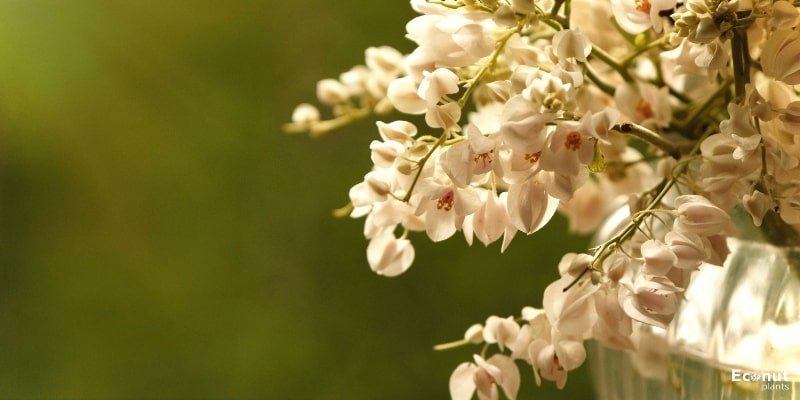
Scientific Name: Antigonon leptopus
Plant Type: Perennial
Sun Exposure: Full sun, Partial Sun
Plant Size: 30-40 feet
The coral vine, sometimes known as the Rose of Montana, is native to Mexico. This vine bears tiny, heart-shaped blossoms and grows quickly. This climber may grow up to 40 feet in length, so it needs full to partial sun, well-drained soil, and a fence or trellis for support.
In the mild USDA zones 9–11, this perennial white flowering vine blooms all year round. The plant blooms in late summer in zones 8 and above, and it dies above ground with the first winter.
15. Potato Vine
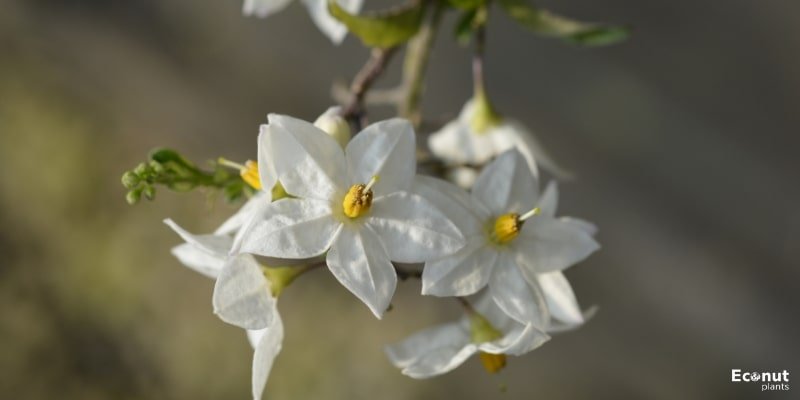
Scientific Name: Solanum jasminoides
Plant Type: Perennial
Sun Exposure: Full sun, Partial Shade
Plant Size: 20-25 feet
One excellent, low-maintenance instance is the potato vine. It offers fewer fragrant blossoms than jasmine, although it looks quite similar. It’s also quite simple to care for the plant.
16. Madagascar Jasmine
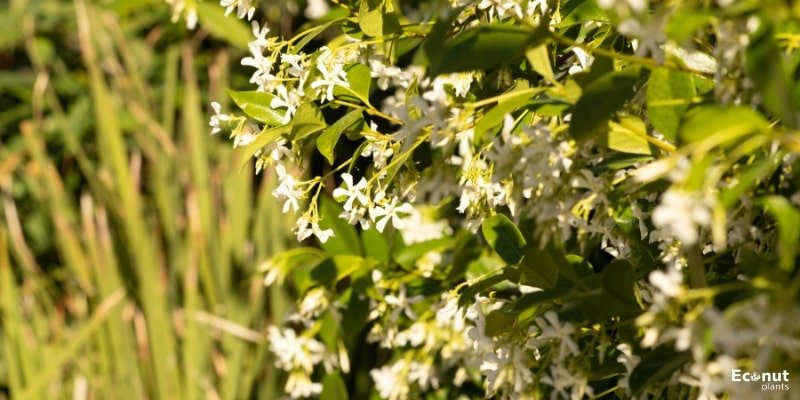
Scientific Name: Stephanotis floribunda
Plant Type: Perennial
Sun Exposure: Full sun, part shade
Plant Size: 20 feet tall
The Deep South is filled with the deep scent of Madagascar jasmine every spring. The dark green, leathery leaves of this graceful perennial vine are crowned with clusters of white, highly perfumed, trumpet-shaped blooms. In the north, you can utilize this low-maintenance vine as a patio plant that can tolerate a cool winter indoors.
17. Holboellia Vine
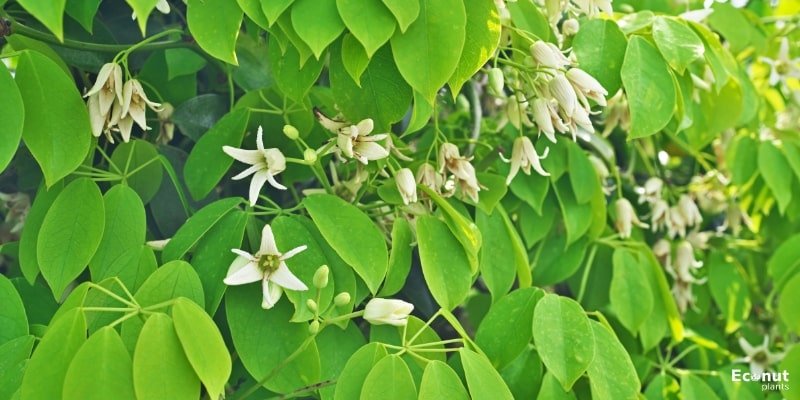
Scientific Name: Stauntonia coriacea. (Diels) Christenh
Plant Type: Evergreen vine
Sun Exposure: Full sun
Plant Size: 20 Feet tall
Heavenly Climb Large, fragrant white flowers bloom in the spring on holboellia plants, which have glossy foliage. It is an excellent evergreen vine for offering seclusion, elegance, and fragrance to the backyard. With assistance, it can reach a height of 20 feet.
18. White Trailing Fuchsia Vine
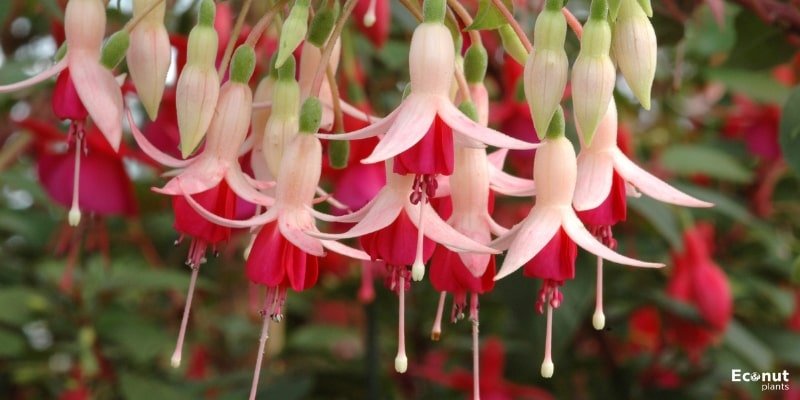
Scientific Name: Fuchsia magellanica
Plant Type: Perennial
Sun Exposure: Full sun, Partial shade
Plant Size: 8–13 Feet tall
Trailing vines bearing bell-shaped white, scarlet, purple, and pink flowers hang in tiny clusters on fuchsia plants. Stamens stick out of the center of the four or five overlapping petals that make up the tubular blooms. The vivid double petals of white fuchsia flowers often contain a hint of pink, which gives them a graceful, romantic appeal.
In full shade, the majority of people cultivates fuchsia plants in hanging baskets or summer container gardens since they are tolerant of chilly temperatures and have long, dangling stems. For visually appealing flower arrangements in the summer, you can also hang fuchsia flowers on patios or deck areas.
19. White Japanese Wisteria
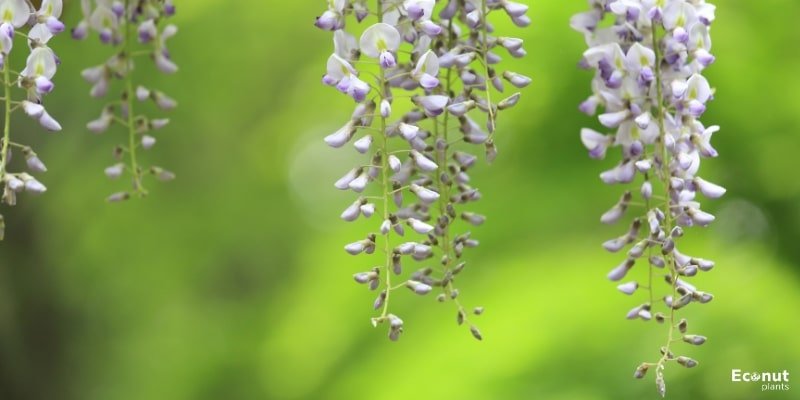
Scientific Name: Wisteria floribunda ‘alba’
Plant Type: Perennial
Sun Exposure: Full sun, partial shade
Plant Size: 10-30 feet
Japanese wisteria blooms in late spring or early summer, with fragrant white blossoms that cascade down the vines. Up to 30 feet can be achieved by the vines, and up to 12 inches can be achieved by the flowers. Due to its attractiveness and scent, Japanese wisteria is a popular plant for gardens and landscaping.
Grown to be a lovely accent to a garden, Japanese wisteria can sometimes be challenging. Being vigorous growers, the vines require a lot of support. Insects and illnesses may also affect them.
20. White Trumpet Vine
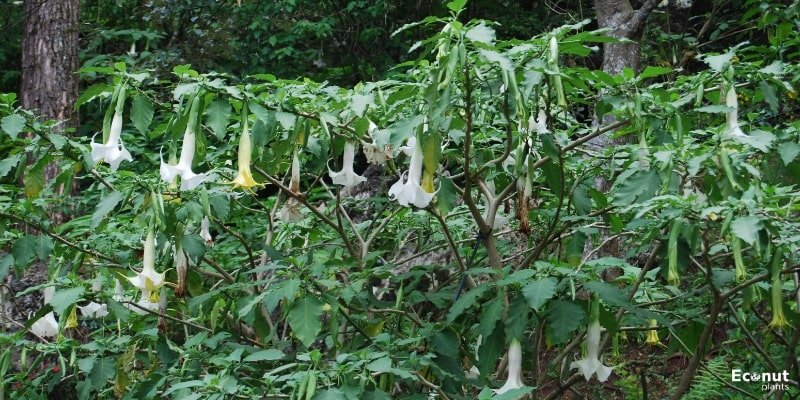
Scientific Name: Thunbergia grandiflora ‘Alba’’
Plant Type: Annual
Sun Exposure: Full to Partial Sun
Plant Size: 10-11 feet
The white trumpet vine, sometimes called the Bengal clock vine or white sky vine, is a strong perennial that blooms huge white blossoms in the summer. The yellow-throated, three-inch-wide flowers are borne in bunches in the leaf axils. The silky, dark green foliage of the vine accentuates the white blossoms.

